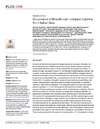Identificador persistente para citar o vincular este elemento:
https://accedacris.ulpgc.es/jspui/handle/10553/74862
| Título: | Occurrence of Brucella ceti in striped dolphins from Italian Seas | Autores/as: | Garofolo, Giuliano Petrella, Antonio Lucifora, Giuseppe Di Francesco, Gabriella Di Guardo, Giovanni Pautasso, Alessandra Iulini, Barbara Varello, Katia Giorda, Federica Goria, Maria Dondo, Alessandro Zoppi, Simona Di Francesco, Cristina Esmeralda Giglio, Stefania Ferringo, Furio Serrecchia, Luigina Ferrantino, Mattia Anna Rita Zilli, Katiuscia Janowicz, Anna Tittarelli, Manuela Mignone, Walter Casalone, Cristina Grattarola, Carla |
Clasificación UNESCO: | 310907 Patología 240119 Zoología marina |
Palabras clave: | Brucella ceti Infections Striped dolphins Cetaceans Mediterranean sea, et al. |
Fecha de publicación: | 2020 | Publicación seriada: | PLoS ONE | Resumen: | This is an open access article distributed under the terms of the Creative Commons Attribution License, which permits unrestricted use, distribution, and reproduction in any medium, provided the original author and source are credited.Brucella ceti infections have been increasingly reported in cetaceans, although a very limited characterization of Mediterranean Brucella spp. isolates has been previously reported and relatively few data exist about brucellosis among cetaceans in Italy. To address this gap, we studied 8 cases of B. ceti infection in striped dolphins (Stenella coeruleoalba) stranded along the Italian coastline from 2012 to 2018, investigated thanks to the Italian surveillance activity on stranded cetaceans. We focused on cases of stranding in eastern and western Italian seas, occurred along the Apulia (N = 6), Liguria (N = 1) and Calabria (N = 1) coastlines, through the analysis of gross and microscopic findings, the results of microbiological, biomolecular and serological investigations, as well as the detection of other relevant pathogens. The comparative genomic analysis used whole genome sequences of B. ceti from Italy paired with the publicly available complete genomes. Pathological changes consistent with B. ceti infection were detected in the central nervous system of 7 animals, showing non-suppurative meningoencephalitis. In 4 cases severe coinfections were detected, mostly involving Dolphin Morbillivirus (DMV). The severity of B. ceti-associated lesions supports the role of this microbial agent as a primary neurotropic pathogen for striped dolphins. We classified the 8 isolates into the common sequence type 26 (ST-26). Whole genome SNP analysis showed that the strains from Italy clustered into two genetically distinct clades. The first clade comprised exclusively the isolates from Ionian and Adriatic Seas, while the second one included the strain from the Ligurian Sea and those from the Catalonian coast. Plotting these clades onto the geographic map suggests a link between their phylogeny and topographical distribution. These results represent the first extensive characterization of B. ceti isolated from Italian waters reported to date and show the usefulness of WGS for understanding of the evolution of this emerging pathogen. | URI: | https://accedacris.ulpgc.es/handle/10553/74862 | DOI: | 10.1371/journal.pone.0240178 | Fuente: | PLoS ONE [EISSN 1932-6203], v. 15 (10 October), (Octubre 2020) |
| Colección: | Artículos |
Citas SCOPUSTM
24
actualizado el 08-jun-2025
Citas de WEB OF SCIENCETM
Citations
21
actualizado el 08-jun-2025
Visitas
98
actualizado el 23-may-2024
Descargas
84
actualizado el 23-may-2024
Google ScholarTM
Verifica
Altmetric
Comparte
Exporta metadatos
Los elementos en ULPGC accedaCRIS están protegidos por derechos de autor con todos los derechos reservados, a menos que se indique lo contrario.
